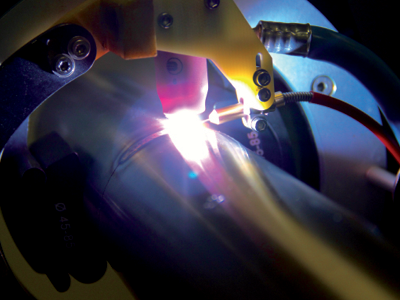Orbital Welding: What Is It and Why Should You Use it?
Welding may be the most effective and structurally sound way to connect metal parts, but certain applications come with their own set of challenges. For example, pipes and tubes, require a consistent, circumferential welds which can be challenging to accomplish manually. Semiautomatic orbital TIG welding allows for a quality weld of rounded parts by rotating the welding head around stationary pipe or tubing. Because of this, it is frequently used to weld difficult-to-reach joints in limited spaces.
Orbital welding was first used in the 1960s when the aerospace industry recognized the need for a better joining technique for aerospace hydraulic lines. Today, orbital tube welding serves a wide range of high-technology industries that require tubing systems such as aeronautics and aerospace, biopharmaceutical processing, food and chemical processing and electronics and semiconductor equipment manufacturing.
Orbital TIG welding allows an operator to maintain precise control of amperage and heat input, travels speed and filler metal use, in order to achieve consistent, reliable welds of high strength, continuity and cleanliness, with minimal deformation or contamination.
Now that we’ve taken a step back to learn more about orbital welding, its history and applications, let’s continue to discuss some additional benefits of this semiautomatic welding process.
6 Advantages of Orbital Welding
1. Higher Weld Quality
While skilled manual welders can certainly create high quality welds for specific purposes, an orbital weld performed using the right equipment and settings can result in a better quality weld. This can be crucial in applications within certain industries like the semiconductor and pharmaceutical industries, where there are strict requirements to be met. 
2. Higher Productivity
Orbital welding is a much more productive use of labor, as the machinery is doing the majority of the work and does the work faster than manual methods. Though there are upfront costs to acquire the appropriate equipment, it cuts down on labor requirements and lead time in the long run.
3. Error Reduction
While manual welds performed by a skilled technician can be accurate, there is bound to be some level of variability and inconsistency between welds. Alternatively, orbital welding is entirely programmable. Welders can set the welding equipment to a specific program, allowing the system to repeat the exact same welds over and over again, minimizing error or defects.
4. Practicality
Orbital welding equipment allows welding in all situations, including confined spaces, lack of visibility and high-risk environments. Welding can be performed from a remote location and a special welding camera can be added to the equipment, reducing risk for the operators.
5. Ease of Use
Manual welding requires the operator to be practiced in the particular welding process being used, have experience with the properties of the metals and alloys being welded and be able to maintain efforts for long shifts and large scale projects. In contrast, operating orbital welding equipment is possible without a long and tedious training program and does not require you come from an accomplished welding background. Training sessions are typically much shorter and easier compared to those of a specialized welder.
6. Cost Reduction
Because orbital welding uses automated processes, it is much more efficient and cost-effective than manual welding practices. The mechanization of the orbital welding process helps to reduce the time needed to actually perform the welds. With less production time needed for the welds, your shop can experience significant cost savings. Additionally, since orbital welding reduces the chance for error or defects, less time and money is spent on repairs.
Contact Linde




























